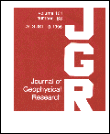 |
Volcano wide fringes in ERS SAR interferograms of Etna: Deformation or tropospheric effect?
François Beauducel, Pierre Briole, and Jean-Luc Froger
Journal of Geophysical Research, Vol 105, No B7, Pages 16,391-16,402, July 2000.
Poster V52A-02 presented at AGU Fall Meeting 1999, Special Session V03: InSAR Imaging of Active Magmatic Processes.
|
Abstract.
Mount Etna (3300 m) is the volcano that has been first and most studied by DInSAR. Previous papers gave evidence for a large scale deformation of the entire edifice consistent with unrest episodes, but with a poor fit with classical elastic models. Also, atmospheric effects on mountainous areas are known to be very significant. Accordingly, interferograms may reflect both deformation and tropospheric effects. We investigate here the possibility of evaluating and correcting tropospheric effects directly from the interferograms. From 38 ERS SAR ascending scenes taken from 1992 to 1999, we have computed 238 interferograms. The amount of data allows us to analyze how the coherence is maintained over long periods of time and thus how it reveals the location of permanent scatters. From a simple analysis of phase-elevation relation, we give evidence for the clear difference in pattern between stratified tropospheric effects and large scale deformation produced by a source in a 3-D elastic body with topography. Using combination of inversion processes, we analyze both deformation source and tropospheric effects for the complete set of 238 interferograms. Finally time evolution of the parameters and modeling probability estimation are retrieved for each SAR image. Estimated relative change in tropospheric delay varies in time from 2.7 to +3.0 (± 1.2) fringes. They are consistent with other tropospheric estimations at Etna based on ground met and GPS observations on the same period of time. Magmatic volume variations remain below error bars and thus cannot be estimated properly. Finally, some of the interferograms may be entirely explained by the difference in tropospheric conditions between the two acquisition periods, without the need to invoking a deformation of the volcano.
Download the paper (© AGU 2000JB900095): 

See also the related paper: [Briole et al., 1999]
